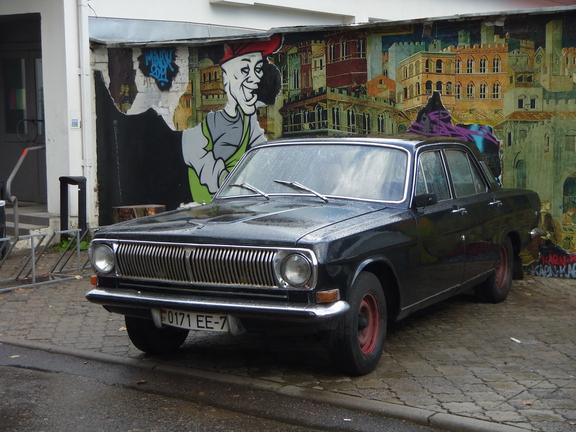a little Minsk bookshelf (iii)
Posted: 31/10/2011 Filed under: Belarus, Books | Tags: Andrei Liankevich, Belarus, black and white photobooks, little Minsk bookshelf, photobooks from Germany, photobooks from Lithuania Leave a comment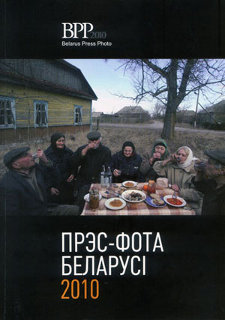 BPP 2010 Belarus Press Photo (Прэс-фота Беларусі 2010). Kaunas: Arx Baltica, 2011. ISBN 978-9955-39-116-6 (Worldcat). In Belarusian, Russian and English. (And no, not Lithuanian. Worldcat has got that wrong.)
BPP 2010 Belarus Press Photo (Прэс-фота Беларусі 2010). Kaunas: Arx Baltica, 2011. ISBN 978-9955-39-116-6 (Worldcat). In Belarusian, Russian and English. (And no, not Lithuanian. Worldcat has got that wrong.)
This runs to 144 excellently printed pages. About half of it is devoted to gags, lovable dogs, fashion shots, sports moments, and so forth; but even if you’re as little interested in these as I am, and if you discount some repetition elsewhere — perhaps there are a few too many photographs of border guards and would-be members of crack police/military units undergoing training or tests — you still get a lot of worthwhile photography for your money. If you thought Grimaces of the Weary Village was surreal, how about (on p.59) a masked, white-clad employee of the Palessie State Radiation Ecological Reserve monitoring radiactivity just metres away from the farmer holding a blowtorch to a dead pig? This masterpiece is one of several by Viktor Drachev (of AFP), some of whose work you can see on this page. Among the other photographers is Andrei Liankevich, on whom see below.
All of this is the result of the first Belarusian press photo competition, with a mostly Russian and Lithuanian jury but organized by Belarus Press Photo. The organizers hope that it will become an annual event. The photographs in this first volume go back to 2006 or so, so this time we’re looking at the best in roughly four years. If I guess the meaning of the colophon correctly, there are just 1000 copies; get yours and thereby help finance “BPP2011”. I bought my own copy at Logvinau but here it is at MIPP, for example.
 Andrei Liankevich. Focus on Belarus: Andrei Liankevich, Fotografien / Photographs / Фотаздымкі. Leipzig: Swen Steinberg and Daniel K. W. Trepsdorf, 2008. No ISBN; not in Worldcat.
Andrei Liankevich. Focus on Belarus: Andrei Liankevich, Fotografien / Photographs / Фотаздымкі. Leipzig: Swen Steinberg and Daniel K. W. Trepsdorf, 2008. No ISBN; not in Worldcat.
You can read about the exhibition by Andrei Liankevich (Андрэй Лянкевіч, Андрей Ленкевич) of which this is the catalogue here (it was part of Focus on Belarus: Terra Incognita), see some of the photographs here, here and in this PDF, and see the book here.
A variety of scenes of Belarus. There are just 38 photographs, but none of them is filler and they’re all excellently reproduced. The informative captions are in German, English, and Belarusian. There’s an introductory essay by Ingo Petz that’s enthusiastic but (perhaps due to deficiencies in translation) is so to an absurd degree.
“Idea, conceptual design, compilation” are credited to Steinberg; the book is “issued by” Steinberg and Trepsdorf.
The book is not easy to find. No library obviously possesses a copy. Anzenberger used to have signed copies for $35 but now has unsigned copies for $60.
Liankevich’s later book Pagan is very different. (As it happens, I like them both.)
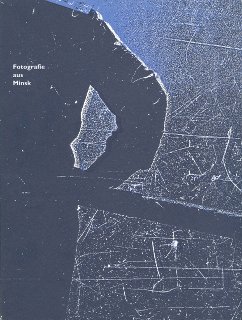 Fotografie aus Minsk: Uladzimir Parfianok, Igor Savchenko, Galina Moskaleva, Sergey Kozhemyakin, Vladimir Shaklevich. Berlin: ifa-Galerie Friedrichstraße, 1994. No ISBN; OCLC 214607452 etc; here (and elsewhere) at Worldcat.
Fotografie aus Minsk: Uladzimir Parfianok, Igor Savchenko, Galina Moskaleva, Sergey Kozhemyakin, Vladimir Shaklevich. Berlin: ifa-Galerie Friedrichstraße, 1994. No ISBN; OCLC 214607452 etc; here (and elsewhere) at Worldcat.
A well-printed but slim exhibition catalogue whose text is in German only. I got it from ABE as the title sounded intriguing and the price was low. It turns out to be less photography than artists doing arty things with cameras and found photographs (or their own photographs made to look found): all worthy no doubt, but to me unexciting. The content, all monochrome or approximately so, is by Uladzimir Parfianok (Уладзімір Парфянок, Vladimir Parfenok, Владимир Парфенок), Igor Savchenko (Игорь Савченко), Galina Moskaleva (Галина Москалева), Sergey Kozhemyakin (Сергей Кожемякин) and Vladimir Shaklevich, each of whom gets a text introduction and also a CV. If I could read German I might then be enlightened by the texts and find the work fascinating, but I doubt it. Yet several of these photographers exhibit other, more interesting series on the web, so don’t rush to discount them. And as for what’s in this catalogue, your sensibilities may of course be artier than mine.
Copyright of the cover images above of course belongs to the respective publisher or photographer, not to me.
a little Minsk bookshelf (ii)
Posted: 08/10/2011 Filed under: Belarus, Books | Tags: architecture, Belarus, guidebooks, little Minsk bookshelf, Minsk Leave a commentTwo more worthwhile books (in addition to these), and other tips.
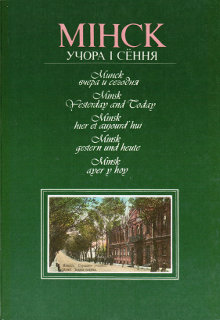
Vassili Kaleda (Василий Каледа). Minsk Yesterday and Today (Мінск. учора і сёння / Минск. вчера и сегодня / Minsk hier et aujourd’hui / Minsk gestern und heute / Minsk ayer y hoy). Minsk: Belarus, 1989. ISBN 5-338-00273-6 (Worldcat, Open Library).
A collection of photographs (as well as a handful of engravings) of Minsk. By today’s standards, the quality of the binding, paper and printing is mediocre, and at first glance this is succeeded and surpassed by Minsk: A Journey through Time (2008). But the older book has a much greater variety of photographs than the newer one, and despite being in each of six languages — Belarusian, Russian, English, French, German and Spanish — its captions are much more informative.
I found my copy at AbeBooks, which has a good supply of these at very palatable prices.
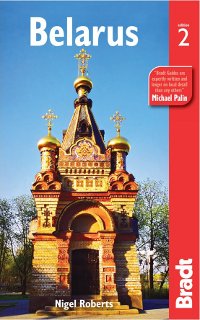
Nigel Roberts. Belarus. 2nd ed. Chalfont St Peter, Bucks: Bradt, 2011. ISBN 978-1-84162-340-5 (Worldcat).
If you’re familiar with Bradt guidebooks, then this one is much as you’d expect; although the author is (via WOVA) involved in Belarus to an above average degree, and Belarus is more than averagely productive of anecdotes (by the author and others) that you’ll want to read and reread. Only a fifth or so of the book can be devoted to Minsk; the coverage doesn’t and can’t go very deep. But though I didn’t venture beyond Minsk, I got my money’s worth.
In summer 2011 I didn’t notice this in any Minsk bookshop (though as I already had a copy I wasn’t looking for a second). If you’re thinking of going to Belarus and wondering whether or not to buy a copy, don’t assume that you’ll be able to do so after you arrive.
 Minsk in Your Pocket.
Minsk in Your Pocket.
I’ll skip the bibliographical palaver for this one as you have at least three simple ways of viewing it almost immediately:
- spread over a website (here)
- as a Scribd iPaper (conspicuously linked from the above)
- as a (7 MB plus) PDF (here)
In printed form, it’s in any of various Minsk bookshops.
If you’ve already been anywhere for which there’s a [wherever] in Your Pocket, then you’re probably familiar with it; and if you haven’t or aren’t, then take a look at the list of destinations. There are eight in Albania alone . . . though admittedly only one in Belarus.
 Bradt’s guidebooks (and Lonely Planets and so forth), and the “In Your Pocket” series, are all very well, but sometimes I want the detail one gets in a real guidebook. Alas there will never be a Minsk and Its Lagoon: Historical-Artistic Guide, but there does exist Nagel’s Encyclopedia–Guide U.S.S.R., whose 5th edition (ISBN 2-8263-0796-7) is as recent as 1986. I haven’t seen it but learn that it runs to over a thousand pages; and others in the series that I have seen suggest that each page will be packed with information. Used in conjunction with something newer, this book could reveal much that’s not obvious. (Cf Ian Johnson’s account of his use in 1984 of what sounds like the 1968 edition of Nagel’s Encyclopedia–Guide China.)
Bradt’s guidebooks (and Lonely Planets and so forth), and the “In Your Pocket” series, are all very well, but sometimes I want the detail one gets in a real guidebook. Alas there will never be a Minsk and Its Lagoon: Historical-Artistic Guide, but there does exist Nagel’s Encyclopedia–Guide U.S.S.R., whose 5th edition (ISBN 2-8263-0796-7) is as recent as 1986. I haven’t seen it but learn that it runs to over a thousand pages; and others in the series that I have seen suggest that each page will be packed with information. Used in conjunction with something newer, this book could reveal much that’s not obvious. (Cf Ian Johnson’s account of his use in 1984 of what sounds like the 1968 edition of Nagel’s Encyclopedia–Guide China.)
Copyright of the cover images above of course belongs to the respective publisher, author or editor, not to me.
So. Farewell then, Minsk
Posted: 08/10/2011 Filed under: Belarus | Tags: architecture, Minsk Leave a commentA taxi took me to the station before the sun had risen. I’d brought my pile of rubles down to just about enough to buy a couple of cellophane-wrapped sandwiches (unlike superficially similar Japanese artifacts, these were tasty, and on bread worth eating), which was lucky as the money exchange counters were only selling rubles, and not buying them.
The inside of the station, looking out:

I took the expected photographs: the timetable, etc. But now I find that Yusuke Inoue, a connoisseur of 旅と写真といい女 (tabi to shashin to ii onna), has beaten me to it. Here‘s his page (or if you’d prefer googlinglish to Japanese, then here).
I popped outside for a few moments and there saw:
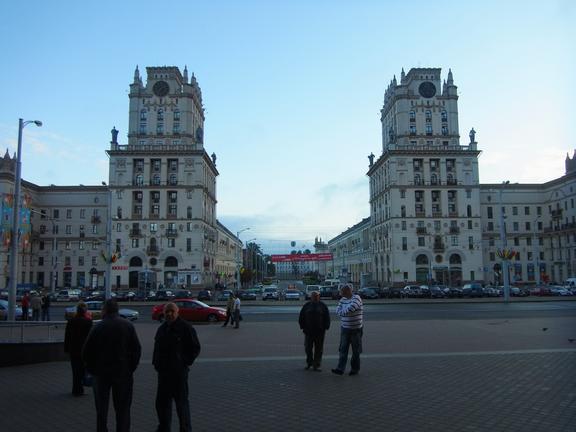
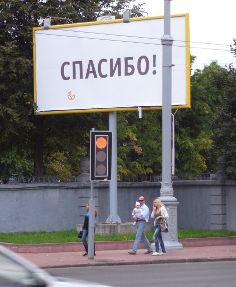 That is of course the proper entrance to Minsk.
That is of course the proper entrance to Minsk.
I took the train from Minsk to Vilnius; Inoue took it from Vilnius to Minsk. I can show you my own handsome ticket for the improbably inexpensive journey, but he is already showing his, and I mustn’t waste more of what space remains in the interwebs. The photographs I took, he took better; and he took some that I didn’t.
So much for my four and a half days in Minsk in 2011. I hope to return — to explore the courtyards behind the façades, the museums, the churches, and the outskirts.
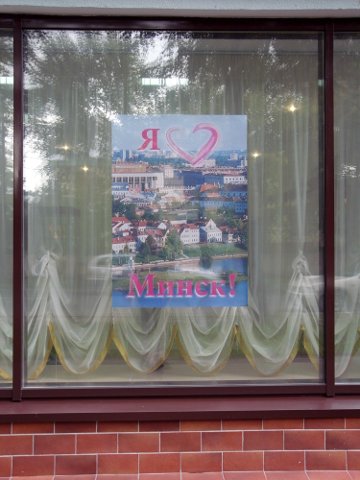
hip Minsk
Posted: 05/10/2011 Filed under: Belarus | Tags: benches, coffee, Guardian, hipness, Minsk, street furniture, twaddle 1 Comment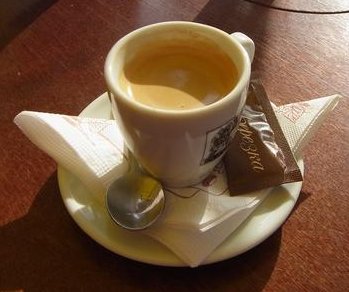 As hipster destination, Minsk has considerable competition. Just according to the Guardian, recent cool destinations have been Mexico City and Marseille (both 2005), Istanbul (2006), and the Canaries and Croatia (both 2007); in 2007 the competition for coolth was intense, and the Canaries and Croatia were trumped by uber-cool New York City. Hip destinations have been Belgrade (2005), Amsterdam and Sitges (both 2006), the Canaries (2007), Hvar (2008) and the Dominican Republic (2009); in 2007 they were beaten by uber-hip Berlin. Edgy destinations have been St Kilda (2001), downtown NYC (2003), Marseille and Mexico City (both 2005), Almaty (2007) and Shoreditch (2010). (Surprisingly, none of the discerning writers for the Guardian seems yet to have described any destination as uber-edgy.)
As hipster destination, Minsk has considerable competition. Just according to the Guardian, recent cool destinations have been Mexico City and Marseille (both 2005), Istanbul (2006), and the Canaries and Croatia (both 2007); in 2007 the competition for coolth was intense, and the Canaries and Croatia were trumped by uber-cool New York City. Hip destinations have been Belgrade (2005), Amsterdam and Sitges (both 2006), the Canaries (2007), Hvar (2008) and the Dominican Republic (2009); in 2007 they were beaten by uber-hip Berlin. Edgy destinations have been St Kilda (2001), downtown NYC (2003), Marseille and Mexico City (both 2005), Almaty (2007) and Shoreditch (2010). (Surprisingly, none of the discerning writers for the Guardian seems yet to have described any destination as uber-edgy.)
The first requirement for being a hip, cool and edgy destination is of course a supply of decent espresso, so that the intrepid traveller will suffer no change from routine home recreational drug consumption. Fear not, caffeine addicts: Minsk delivers. (The example above is from a café right on Victory square oval.) Espressos are cheap (which is not so edgy) but they are excellent. And they’re served hot, which is cool.
But this is only the start. You need style too, and Minsk has it.
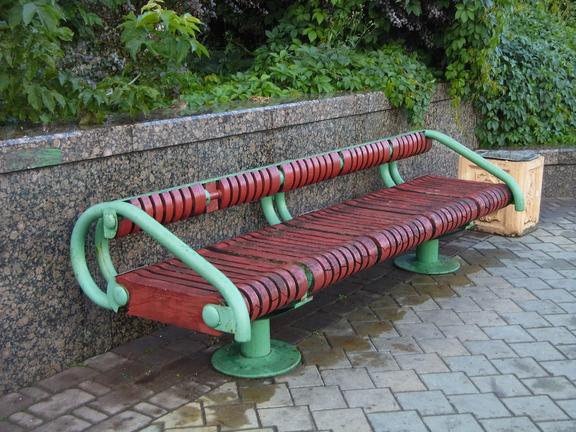
And it has thomassons by the row.
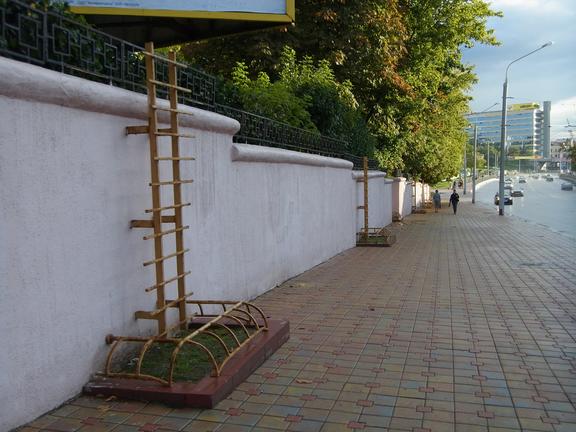
All in all, Minsk is swell.
a little Minsk bookshelf (i)
Posted: 01/10/2011 Filed under: Belarus, Books | Tags: art, Belarus, black and white photobooks, guidebooks, little Minsk bookshelf, Minsk, photobooks from Belarus, postcards Leave a commentHere are some books that I recommend.
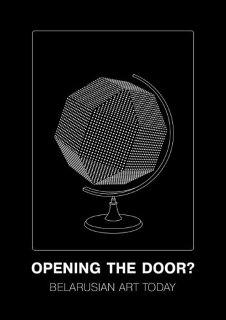 Julija Fomina and Kęstutis Kuizinas, eds. Opening the Door? Belarusian Art Today. Vilnius: Šiulaikinio meno centras / Contemporary Art Centre, 2010. ISBN 978-9986-957-48-5 (Worldcat).
Julija Fomina and Kęstutis Kuizinas, eds. Opening the Door? Belarusian Art Today. Vilnius: Šiulaikinio meno centras / Contemporary Art Centre, 2010. ISBN 978-9986-957-48-5 (Worldcat).
The book to accompany an exhibition of the same name held at ŠMC/CAC in 2010–11. Four texts, and brief introductions to the work of each of eighteen Belarusian artists (or pairs of artists, etc). Despite its single English title, it’s trilingual: English, Lithuanian and Russian.
I bought my copy at ŠMC/CAC, which lists its publications but doesn’t obviously state how they may be ordered.
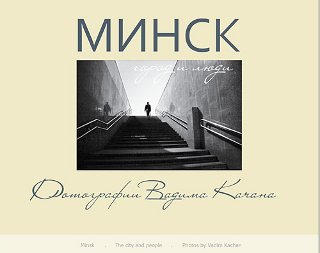 Vadim Kachan (Вадим Качан). Minsk: The City and People (Минск. Город и люди). Minsk: Artia Group, 2011. ISBN 978-985-6893-29-5. (This should find it in Worldcat, but at the time of writing does not do so.)
Vadim Kachan (Вадим Качан). Minsk: The City and People (Минск. Город и люди). Minsk: Artia Group, 2011. ISBN 978-985-6893-29-5. (This should find it in Worldcat, but at the time of writing does not do so.)
A book of black and white photographs by Vadim Kachan of Minsk, with captions and short texts in both Russian and English. It’s affectionate but not too postcardy — it’s the kind of book of which Prague provides many examples. Reproduction quality is serviceable. You can see the book, or an exhibition of the work it contains, here, here, and here.
The book is labelled “Masters of the Belarusian Photography”, suggesting that it’s one volume within such a series. I didn’t see any other volume; perhaps some are on their way.
In summer 2011 this was available in Minsk bookshops.
 Chrystaphor Khilkevich (text) and Siarhei Plytkevich (photography). Minsk in One Day: Guide-book. 3rd (?) ed. Minsk: Riftour, 2007. ISBN 978-985-6700-55-5 (Worldcat).
Chrystaphor Khilkevich (text) and Siarhei Plytkevich (photography). Minsk in One Day: Guide-book. 3rd (?) ed. Minsk: Riftour, 2007. ISBN 978-985-6700-55-5 (Worldcat).
Yes, this purports to be a guidebook for one day in Minsk. It would be an eye-opening, educational, but long and exhausting day. The text is intelligent, the photographs are good, and it’s all ingeniously indexed; but the format is too large to let it fit into any normal pocket. However, even if you don’t use this as a guidebook, it’s worth buying and reading. It’s in English only, but editions in other languages also exist.
In summer 2011 this was available in Minsk bookshops.
 Vladimir Likhodedov (Владимир Лиходедов; Владімір Ліходедов). Minsk: A Journey through Time (Минск. Путешествие во времени / Мінск. Падарожжа ў часе). Minsk: Technalogia, 2008. ISBN 978-985-458-167-5 (Worldcat, Open Library).
Vladimir Likhodedov (Владимир Лиходедов; Владімір Ліходедов). Minsk: A Journey through Time (Минск. Путешествие во времени / Мінск. Падарожжа ў часе). Minsk: Technalogia, 2008. ISBN 978-985-458-167-5 (Worldcat, Open Library).
A handsome, substantial book (height 32 cm) that pairs postcards of Minsk as it once was (before the Soviet period or anyway before the war) with photographs of it as it was around 2008. Captions and text are in Russian, Belarusian and English. An index would help, but the content is well organized.
My own copy emphasizes Russian on its front cover and spine (although its colophon is in Belarusian), but plenty of images of the front cover on the web are of a design that emphasizes Belarusian instead; I’d guess that there’s one book with a choice of covers.
In summer 2011 the book was widely available in Minsk bookshops (as were other similarly tempting books, which I didn’t buy, in the same series).
Book prices in Belarus are not fixed and the “list”/recommended price isn’t printed on the book — or anyway I don’t notice any price printed on or in any book that I bought there. This means that the price of a given book may be higher in one shop than in another, and inconspicuously so. But Belarusian books in either Russian or Belarusian (as well perhaps as one or more other languages) are priced distinctly low by US/British standards, and those that are only in English are priced reasonably too. Moreover, the prices for a particular book don’t vary much. So don’t waste your time “comparison shopping”, and don’t be offended when you discover you could have saved a small amount by buying in some other shop.
Copyright of the cover images above of course belongs to the respective publisher, author or editor, not to me.
more Minsk
Posted: 01/10/2011 Filed under: Belarus | Tags: Minsk, streets Leave a commentBecause of course you can never have too many photographs of Minsk. First, my Jeff Mermelstein tribute:

And the others:
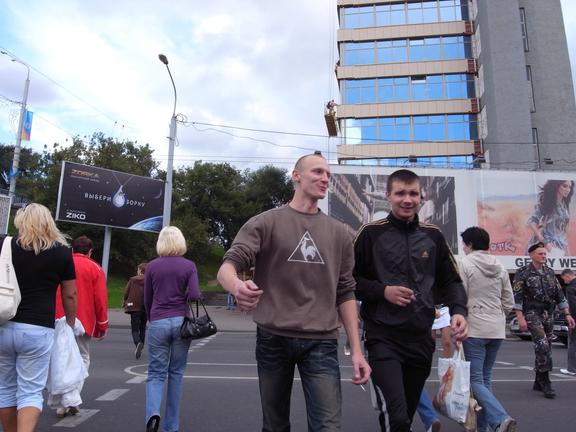


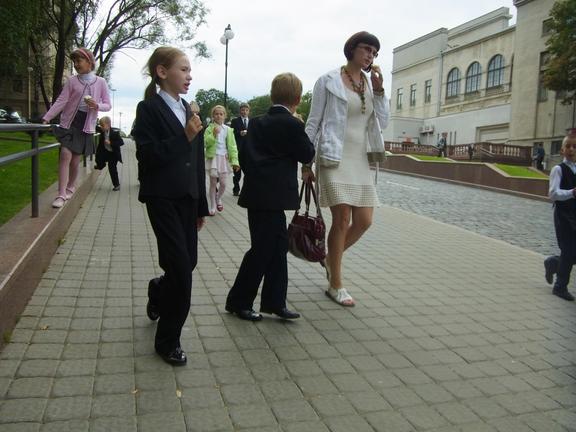




Minsk after the rain:

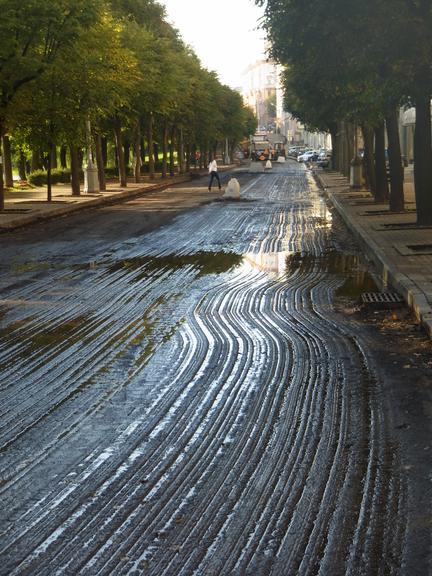
corners of Minsk
Posted: 01/10/2011 Filed under: Belarus | Tags: Minsk, streets Leave a commentOf course I had to photograph where Marx crosses Lenin (or where K. Marksa crosses Lenina, if we’re being pedantic):

I did the same for where Marx crosses Engels, but seem to have mislaid the photo. Anyway, here we are on an unremarkable corner some way from Lenin along Marx:

Some corners are round:
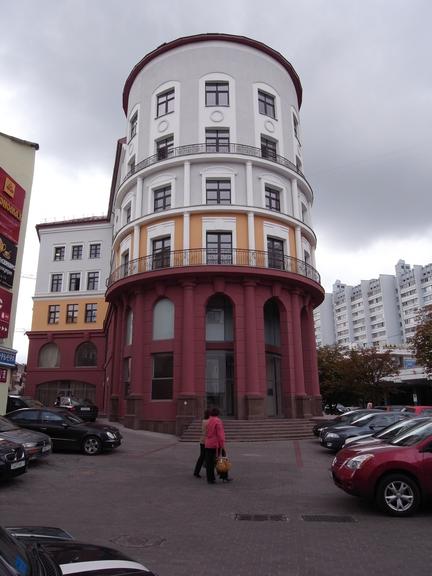
And two more corners:
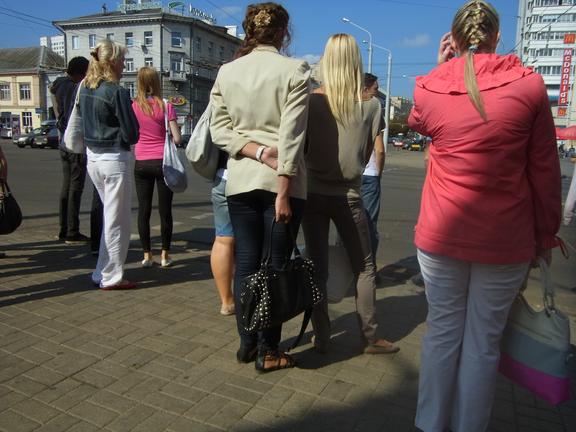

Minsk theatres
Posted: 30/09/2011 Filed under: Belarus | Tags: architecture, cinemas, Minsk, opera houses, theatres Leave a commentOr anyway, “theatres” broadly defined.
We’ve already seen the Moskva (Москва) cinema on Pobediteley avenue, but here’s the Pobeda (Победа) cinema on Internatsionalnaya street in Minsk:
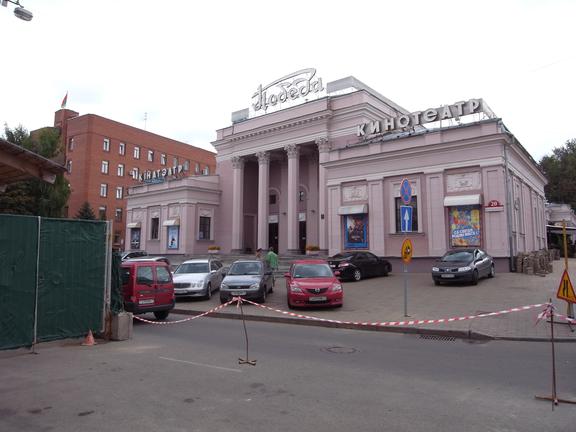
And what it’s showing:

Here’s the Belarusian National Opera & Ballet Theatre:
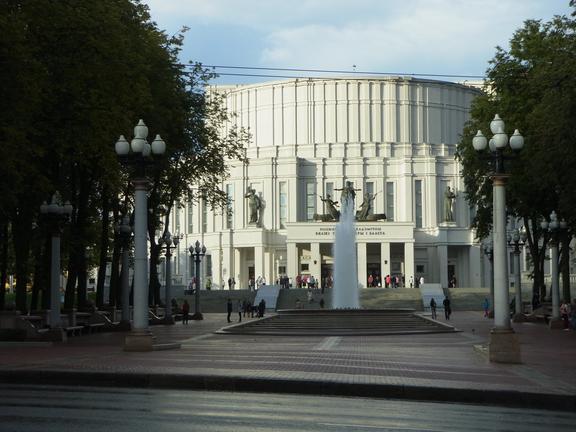
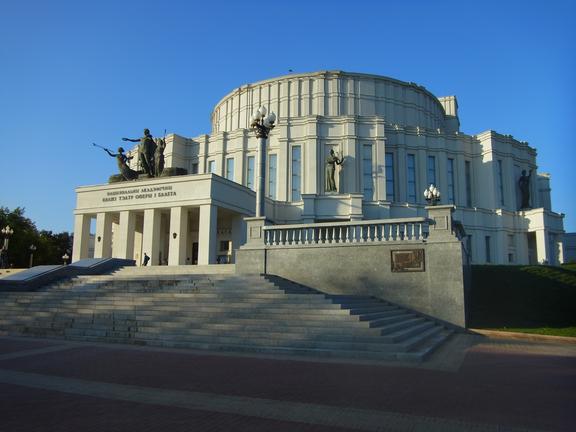
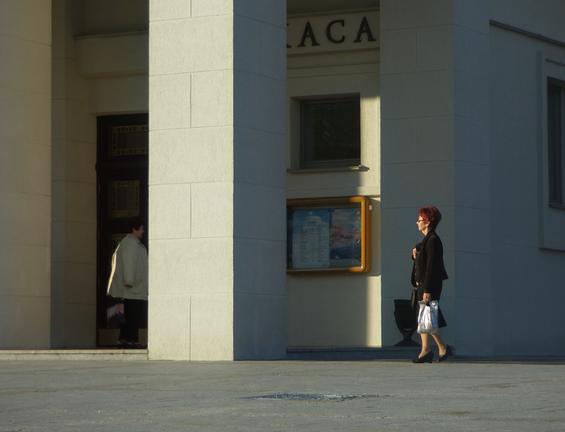
It’s clear from this page about the history of the building that it has recently been restored.
But what more dramatic way to announce a theatre than with a tank in front? (Other sites say that the tank is a T-35/85, a model written up here.) Below, the Drama Theatre of the Belarusian Army, on Krasnoarmeiskaya street.
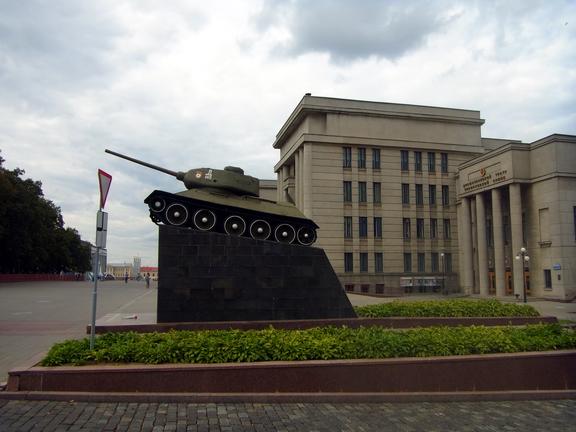
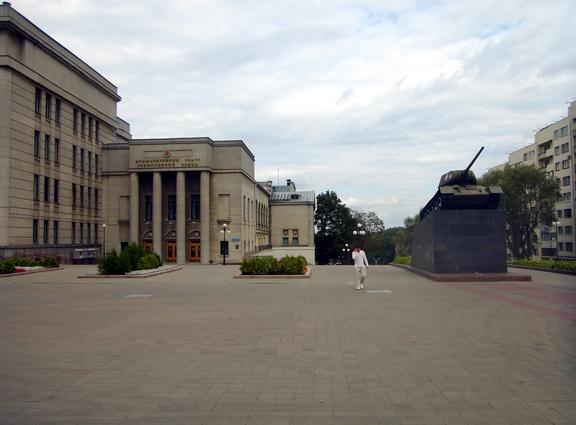
Nezavisimosti avenue
Posted: 30/09/2011 Filed under: Belarus | Tags: architecture, Minsk, streets Leave a commentNezavisimosti (Nyezhavizhimosty, Nezalezhnasti, Independence) avenue (or prospect) (Belarusian праспект Незалежнасці; Russian проспект Независимости) runs through the centre of Minsk from the station at the southwest up through Nezavisimosti, Oktabrskaya and Victory squares.
The avenue is based on Zakharievskaya street, imposed on Minsk from a plan made at the end of the eighteenth century under Minsk’s governor Zakharia Korneev, after whom it was named. By the end of the nineteenth century it was a fashionable street as well as a major thoroughfare. In 1922 it was renamed Sovetskaya (Savetskaya). During the war it and Barysau were largely destroyed. After the war the wide and grandiose Stalin avenue was built in its place. It’s over 11 kilometres long and its width varies between about 50 and about 70 metres.
Minsk in One Day points out that “Together with adjacent streets the avenue forms the largest and most integral ensemble of what is known in modern architecture as ‘Stalin Empire style’.”
Lenin’s personality cult was of course undamaged by the deflation of Stalin’s; in 1962 the avenue became Leninsky. In the 1990s it was again renamed, to Skorina (or Skaryny) avenue (after this man). And in 2005 it was renamed yet again.
I haven’t yet read anywhere whether the name is supposed to celebrate independence as a general concept, or some particular independence. If it’s the latter, I wonder whose independence from whom is being celebrated.
Conceivably, its own independence from “global” adulation of brand names. Consider: At its widest it’s as wide as the Champs-Élysées, and it’s over five times as long. But it lacks the Parresque spectacle of busloads buying highly advertised tat. And despite its handsome night-time illumination, this building on Nezavisimosti is not a department store.


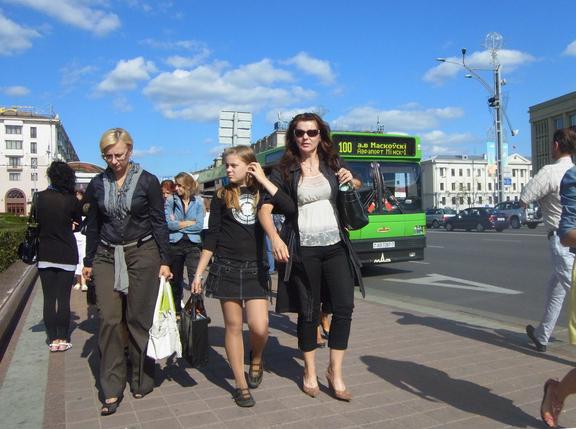




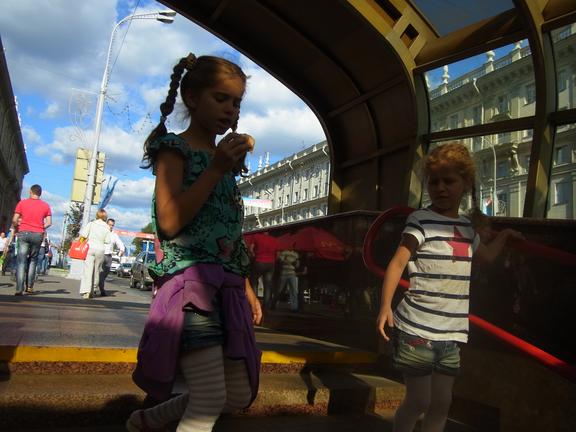
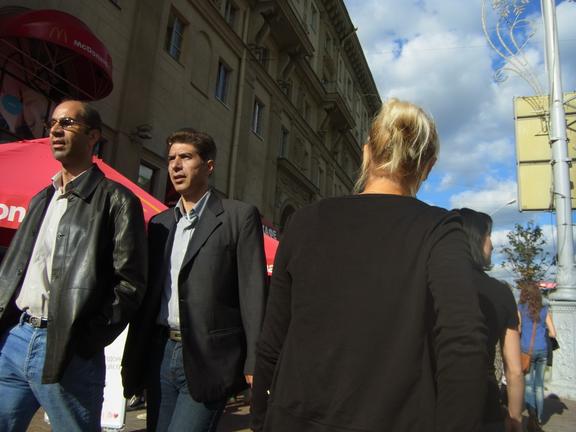
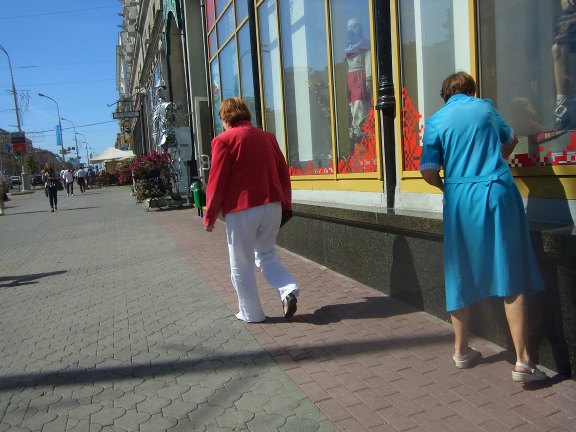
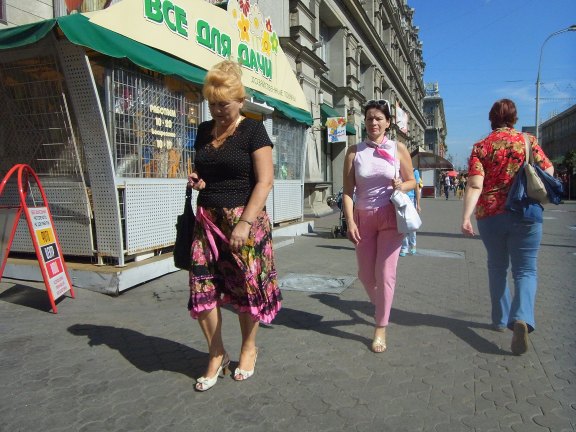
Nyezhavisymosty Ave





Gallery Y, Minsk
Posted: 27/09/2011 Filed under: Belarus, Books | Tags: art, bookshops, Minsk Leave a commentGallery Y (Галерэя сучаснага мастацтва «Ў») is very close to Victory square. It opened in late 2009 and as far as I know it’s Minsk’s sole gallery of contemporary art. The particular exhibition was of limited interest to me, but the adjoining bookshop Logvinau (Кнігарня «логвінаЎ») was very pleasing, as I there first saw several interesting books, notably two by a new name to me, Artur Klinau.
There’s also a cafe/bar, Moloko (Бар «Малако»), in the same building. In Your Pocket makes this sound good.
Bookshop:
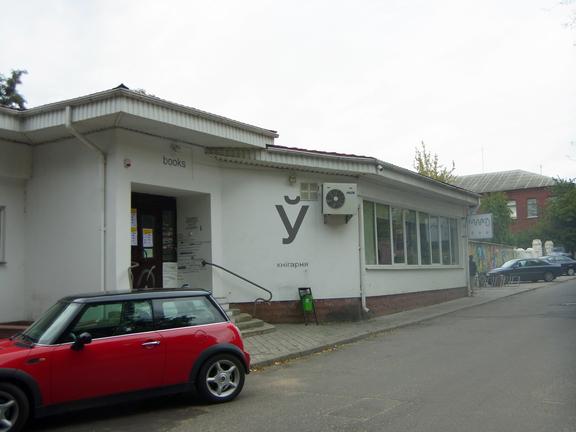
Gallery and cafe/bar:
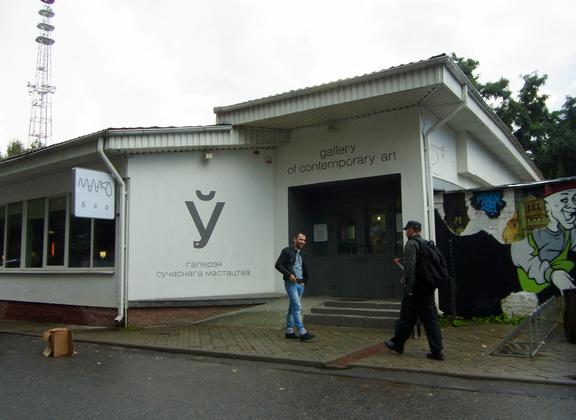
And a Volga for a quick getaway:
